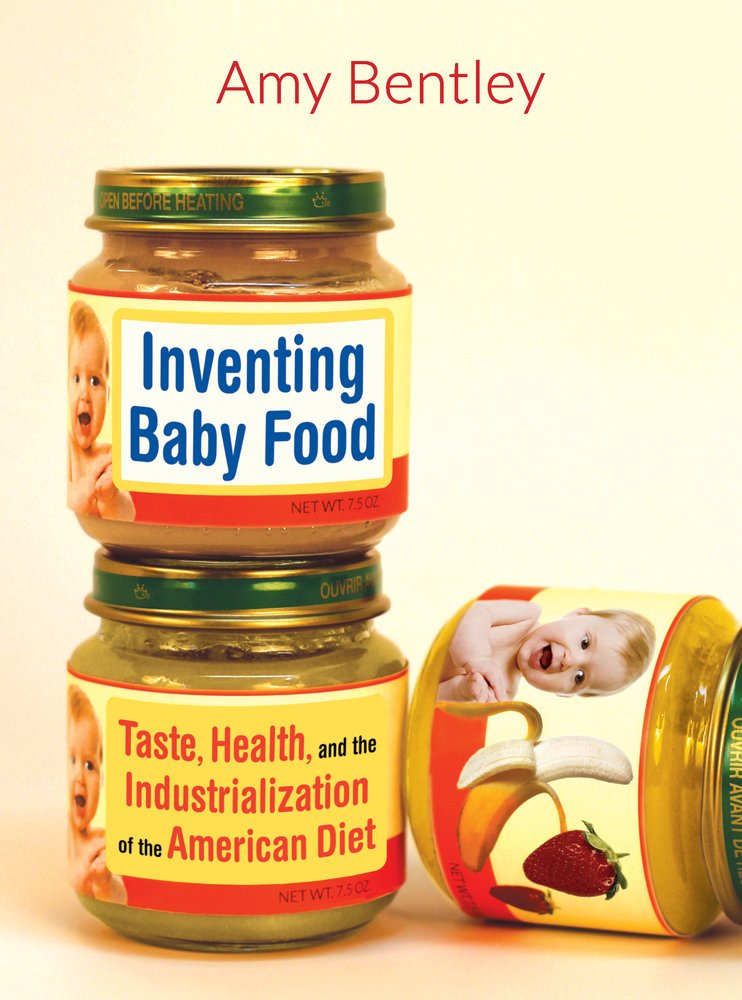Food historian Amy Bentley has a new book called “Inventing Baby Food.” And I met with her at a food lab at NYU to talk about and sample baby food. I started by asking about the birth of the baby food industry.
Brendan Francis Newnam: When was the birth of the baby food industry?

Amy Bentley: It got started in the early 1930s, and it took off pretty rapidly. It was right about the same time that vitamins were discovered, so fruits and vegetables had food value in a way they didn’t have before. People thought, wow, these are important. These aren’t just extras. That was about the same time that advertising takes off and industrialization of the food supply is taking off.
Jars of baby food are developed in the same way that jars of regular food are developed. Manufacturers are seasoning them the way they would season food for adults, with salt or sugar, additives that keep the texture smooth and keep the water from separating. Baby food is manufactured that way. It’s a big hit, in part because of its convenience.
Brendan Francis Newnam: More time to smoke Kents and drink highballs.
Amy Bentley: Exactly. They’re women of leisure. So, they’re very popular, and they continue to gain popularity until, I would say, by the 1950s, they are really an entrenched part of American culture, and probably 90% of American babies are fed commercial baby food. It’s just a rite of passage.
Brendan Francis Newnam: So, when you talk about the industrialization of baby food, I think of Gerber. I picture that little baby. I think that’s what my mom fed me. You have some jars of it here, so maybe we can taste some. This is Gerber ham in ham gravy. The ingredients are fresh ham, water. Oh, I smell it, and it’s about two feet from my face. It’s fresh ham, water, and corn starch.
Amy Bentley: Yeah. So, this ham in ham in ham gravy.
Brendan Francis Newnam: And, we’re going to eat this?
Amy Bentley: Yeah, we are.
Brendan Francis Newnam: All right.
Amy Bentley: So, take some. Look at.
Brendan Francis Newnam: It gets really pink in there, like bubble gum. The top is just gray.
Amy Bentley: It’s gray, and then you get into it, it’s like Pepto-Bismol that is sort of thick. Well, let’s taste it.
Brendan Francis Newnam: All right. Oh. It tastes like a shoelace.
Amy Bentley: It doesn’t really taste like anything.
Brendan Francis Newnam: It’s weird, because it smells strongly of cat food, and yet, it tastes like nothing.
Amy Bentley: I mean, you could probably take some ham at home and grind it up, puree it, add a little water, and create something that actually tasted like ham.
Brendan Francis Newnam: Gerber baby food is still succeeding and is still out there, but a lot of people are moving away from that. What’s going on now in baby food?
Amy Bentley: This is kind of like baby food 2.0. This happened, really got started, about three or four years ago. You start to get the rise of boutique baby food producers, and a lot of them were by mothers who were dissatisfied by what was offered, and wanted different flavors, different textures. Then, the pouch came in and it just took off like wildfire. As you can tell, again, it’s all about convenience.
Brendan Francis Newnam: Yeah. So, this is four ounces. They look like versions of Capri Sun packages.
Amy Bentley: The idea is that you just take off the top, and you can either, if the baby is young, put it in a spoon and feed the child with a spoon, or just take off the top and hand it to the kid, and the kid will suck it like a straw.
Brendan Francis Newnam: So, it’s the packaging, and then also what’s inside has changed.
Amy Bentley: Absolutely. So, what’s inside is different flavors, more organic, part of the food revolution, the idea of ‘good food’ that we think of today. There are some benefits and drawbacks, I would say. It further distances us from thinking about food, as within a meal, which helps contain hunger, which helps contain appetite, which helps set good habits for the future.
Brendan Francis Newnam: So, by not sitting down at a table, this encourages on-the-go, grab-and-go eating.
Amy Bentley: Also what it does is it extends the use of baby food. Before, a very small window that a baby would actually use commercial baby food. Somewhere from four months to maybe 9, 10, or 11 months. As you can see, this one says “From about 12 months.” So, it extends the use of these products for about another year, to age two. Baby food companies are delighted by it.
Brendan Francis Newnam: Can we taste one of these? I don’t know. I’m torn between the organic chicken, vegetables, and quinoa, and the squash and sweet peas.
Amy Bentley: This one is, I don’t even know. Kiwi, spinach, barley and Greek yogurt.
Brendan Francis Newnam: All right, let’s do that one. I’m going for it. Mmm, that’s actually not bad.
Amy Bentley: I’m getting some spinach at the end. This is sweet.
Brendan Francis Newnam: I feel the kiwi in there. It’s a little more complex, actually. It’s not in-your-face sweet. I could actually see myself grabbing this on the go. I could see this changing my whole picnic game. Do they have these in malbec?


